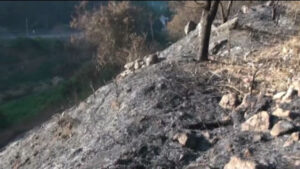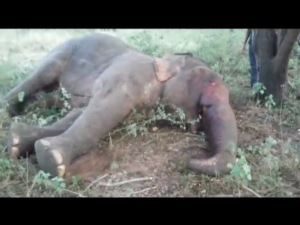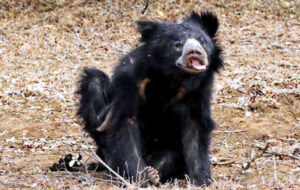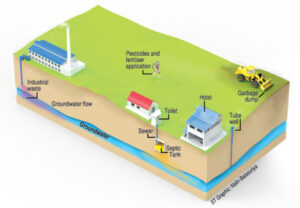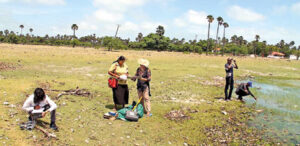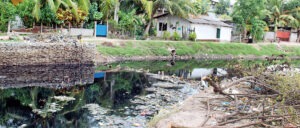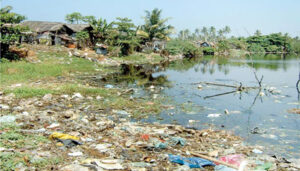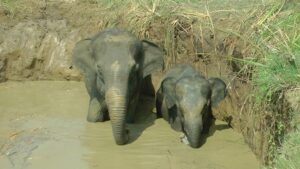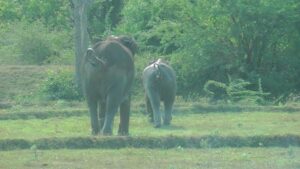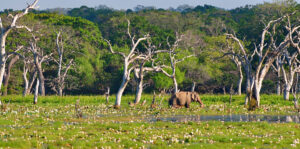
Waste dumping in Sanctuaries
The Department of Wildlife has requested the public to provide them with the information about people who dumped waste in sanctuaries. Our reporters said that the double bend area of Victoria Forest Reserve has been severely polluted by garbage dumping. Environmentalists point out that this could pollute Mahaweli water. Someone has also burnt plastic at the site. The Wildlife Department said that people in the area should be vigilant to minimize such incidents.
Source -20/05/2017, ITN News, see more at – https://www.itnnews.lk/local-news/waste-dumping-in-sanctuaries/

Wild elephant dies in fight with a tusker
A wild elephant has died following a clash between a tusker and an elephant at the Minneriya National Wildlife Park. The fight has broken out between the wild elephant named Netta Kota and the tusker identified as Wasamba. The fight between the wild elephant and the tusker has taken place at Palupitiya area of the Minneriya National Wildlife Park. The Wildlife officials said that a clash could have lasted for about one hour. They said that the left side and the eye of the wild elephant was severely injured. When the wild elephant fell down, the tusker had attacked him again. The Wildlife officials has chased away the tasker into the Wildlife Park but he has returned and attacked the fallen wild elephant again. They said that the wild elephant may have died due to the injuries caused to its stomach by the tusks.
Source – 21/05/2017, ITN News,See more at https://www.itnnews.lk/local-news/wild-elephant-dies-in-fight-with-a-tusker/

Sri Pada Turns Into A Dumping Ground
Many expressed concern last week after it was reported that more than a million plastic bottles were collected from Sri Pada area which was discarded by pilgrims who had travelled to Sri Pada (Adam’s Peak) for past few months.
Environmentalists point out that during months of May and December, some organisations collect garbage especially bottles and plastics from Sri Pada area. However, despite awareness campaigns the trend goes on.
Many are of the view that that though there are polices and guidelines especially by the state institutions like the Central Environmental Authority (CEA), but the enforcement is not satisfactory.
When contacted, Centre for Environmental Justice (CEJ) Executive Director Hemantha Withanage told The Sunday Leader that agencies such as CEA is responsible for plastics and polythene issue not only in Sri Pada but for the whole country.
He said that there was a cabinet appointed technical committee which he was part of and they produced guidelines and regulations to control and ban polythene and plastics.
Producer responsibility
He stressed: “There is no other way to stop this other than banning polythene and introduce extended producer responsibility where the producer would take the responsibility to recycle the bottles and e-waste etc.”
When it comes to plastic bottles and polythene, CEJ have filed action against the garbage gazette, asking for a scientific waste management policy and a mechanism.
“It should be based on zero waste policy. Earlier, we had 3R which is Reduce Reuse Recycle but now all developed countries promote zero waste. This means all waste should be treated as resources for another production process,” he stressed.
A CEA official said that they have limited resources. However, they are in the process of taking all relevant measures making sure for a cleaner environment and rich biodiversity.
He stressed that when it comes to the disposal of plastic bottles, it is a common problem worldwide. Millions of single-use bottles end up in landfill sites or in oceans and a very small proportion are recycled.
“It is the same in Sri Lanka, of course we have strict measures. There are shortcomings as usual when it comes to implementation,” he said.
World Heritage Site
Environmentalist, Dr. Ravindra Kariyawasam who is also Director of the Center For Environment and Nature Studies said that the road leading from Sri Pada to Nallathanni and the surrounding areas were declared as a World Heritage Site of UNESCO a few years back,
He says in other words there should be no construction or renovation without a valid reason and appropriate approvals from the authorities concerned, especially from the UNESCO committee.
It was declared as one of the UNESCO world heritage sites in Sri Lanka for the ecological and biological diversities which need to be protected and reserved without any harm being done to the site.
“Sri Pada has a lot of tourist attraction and was supposed to be protected by the government. But it is being damaged and threatened in the expectation of boosting the tourism industry in the country is not an appropriate plan by the government. Projects aren’t sustainable nor will they be a contributing factor to the tourism industry. The government needs to understand the reality before allowing such projects in such a holy place where people of all religions worship,” he said.
No private and domestic buildings were allowed in close proximity of Sripada for over several years and the government that needs to protect the place is trying to put up unnecessary constructions. The false claims of the developers should be seriously looked into, he noted. Some claim to provide facilities for the devotees who visit the place from various places all around the country and also to foreigners.
“According to the Flora and Fauna Act, they cannot even cut down a single tree in the site how can they clear an area of 99 acres for the construction? Who has the authority to allow such projects in a UNESCO protected site.”
Adam’s Peak is worshipped by all people of the country, the Sinhalese Tamils and Muslims by giving various names for the mountain and the sacred footprint. Adam’s Peak is important also as a watershed.
Precious stones
The districts to the south and the east of Adam’s Peak yield precious stones, emeralds, rubies and sapphires, one thing the island has been famous for. The development projects and the luxury hotels will endanger the sanctuary which is filled with plants and trees.
“We are not against building luxury hotels and cable wire cars to boost tourism in Sri Lanka but Sripada is a place for worship and a UNESCO world heritage site, the government should put in place immediate measures to stop the ongoing project and to conserve the reservation,” he added. He also told The Sunday Leader that they had been campaigning since 2001 from the days at Young Zoologists Association (YZA).
He also said that they had taken up the matter several times with Sabaragamuwa Pradeshiya Sabawa and with the then Minister of Environment and Natural Resources. A report in the British based The Guardian says that it’s estimated Americans throw away at least 50 million bottles every day. Every year, a UK household uses 480 plastic bottles, but only recycles 270 of them, according to Recycle Now, a campaign group funded by the government’s waste advisory group Wrap. A survey by Greenpeace found five out of six global soft drinks firms sold single-use plastic bottles weighing more than two million tones only 6.6 per cent of which was recycled plastic.
Recycling in Sweden, for example, is so effective that they have to import waste to turn into energy, but in most countries schemes are either less efficient or don’t exist at all.
By – Ifham Nizam
source – 21/05/2017,The Sunday Leader, See more at – http://www.thesundayleader.lk/2017/05/21/sri-pada-turns-into-a-dumping-ground/

‘Lichens: the coolest thing you never heard of’
Lichens: the coolest thing you never heard of’, a lecture presided by eminent Sri Lankan lichenologist, Dr. Gothamie Weerakoon, and world renowned lichen specialist Dr Pat Wolseley, scientific advisor to the Natural History Museum London, will concentrate on a scientific dissemination of their insights on the subject. The duo will be joined by National Geographic Young Explorer, Mathew Cicanese, a documentary artist who takes a special interest in small organisms, and human interactions with the environment. This lecture on May 27 at the BMICH, Orchid Room at 6.15 p.m. is a part of the environmental lecture series hosted by Dilmah Conservation.
Admission to the lecture is free and will be open to all.
Lichens exhibit a marked diversity that oftentimes goes unnoticed, even though these symbiotic colonies occupy a major swathe of the earth’s surface as they inhabit nearly every possible nook and crevice on the planet. These symbiotic associations are a curious case of mutually beneficial partnerships between fungus and an alga or cyanobacterium, or both; which function together almost as a single living individual. While these colonies act as carbon sinks, playing a pivotal role in decelerating the global warming process, they also respond to the minutest change in the environment making them crucial to the ecosystem as bioindicators.
The scientific community has shown a keen interest throughout into the study of the mechanisms of their existence and their ecological role, however, unlike the debate on climate change or the conservation of rainforests, and their rich biodiversity, it hasn’t yet grasped the imagination of the masses.
Dr. Gothamie Weerakoon, will be addressing this gap in the awareness regarding the ecological role of lichens through her lecture on Saturday. She is currently working alongside her team of specialists from the National Geographic Society on studying and discovering the plethora of lichens that are present in the tropical terrains of Sri Lanka.
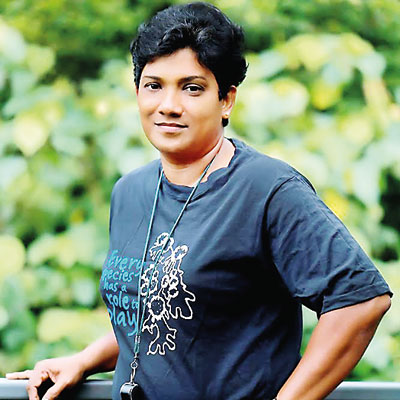
Spource – 21/05/2017,The Sunday Times, See more at -http://www.sundaytimes.lk/170521/plus/lichens-the-coolest-thing-you-never-heard-of-240469.html

Bear necessities, the palu fruits
Tipsy black bear under a palu tree. (Pix by Ajantha Palihawadana)
For the black bear, there is no greater feast than palu fruits straight from the tree. This gastronomic delight makes the nocturnal creature forego its night time pursuits and get intoxicated by palu even during the day! “They are oblivious to the world outside and can be spotted in various positions under the palu trees, some even in yoga position,” says Ajantha Palihawadana, Head of the Responsible Trail, the eco-tourism arm of the Yala Adventure Resort.
Although the flowering season of palu begins at this time of the year and the fruits ripen from June to August, as Palihawadana observes, in the Yala National Park, ripened palu had been spotted since the second week of May this year. “In Yala we noticed a very early flowering season of the fruit this year, as early as February where bees were collecting nectar from the palu flowers.” Perhaps a sign of climate change as Palihawadana reflects, early fruiting means an unexpected lottery for the nocturnal black bear. “The Palu season is the best time to photograph the creature and at times they are seen nestled among the palu branches for hours and if the drought is prolonged, they eat the fallen berries under the trees which are fermented and become drowsy,” says Palihawadana who has captured the ‘tipsy’ bear and its footprints under the palu trees of Yala. The berry is also a staple for other fruit-eating creatures such as the giant squirrel, civet cat and the Gray langur, says the nature lover and researcher.
Botanically termed Manilkara hexandra in the Sapotaceae family, palu or Ceylon Iron Wood is found in abundance in the dry arid zones and along the sandy coast of the country. “Palu is one of the most important components of the vegetation of the ‘dry ever green forests’ in the country, notably in the North, East and the North Central. Yala, Bundala, Wilpattu, Kumana, Udawalawe, and Wasgamuwa National Parks are also well known for the tree . The tree is also prominent along the Southern coast,” explains Prof. Siril Wijesundara, Research Professor, National Institute of Fundamental Studies and former Director General of the Department of National Botanic Gardens. A chief factor of the ‘high canopy’ of these ‘dry ever green forests’, palu trees grow up to about 25-30 metres in height, he says.
Sought after by birds and wild beasts, palu when eaten in excess, could have an intoxicating effect on the two legged and the four. “Growing in the South, palu was part of our lives and I still recall being unable to open our eyes the next day, having been palu gluttons as the berry is believed to be containing ‘heaty’ properties when consumed in excess,” recollects Prof. Wijesundara.
The berry, found largely in the tropical Asian regions and predominantly in the Indian subcontinent, palu is a subject of serious horticultural research in India according to the Botanist. “We too should take a cue from the Indian experience,” maintains the scholar who notes that ripe berries are dried in open air and the dried fruit commercially promoted in India.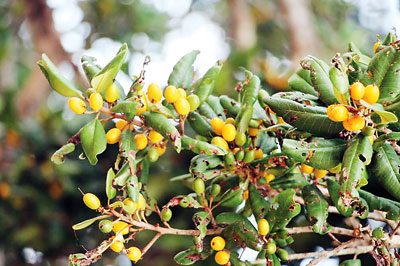
Claiming a ‘characteristic bark’ as Prof. Wijesundara illustrates, the palu tree is also renowned for its adaptations to mitigate water loss. “Palu bark is what is botanically termed a ‘fissured bark’, denoting a dark, thick texture. The leaves of the tree are thick and the edges are curved inwardly with a shiny surface and help prevent water evaporation.” The tree can also withstand coastal climatic hardships, says the Botanist. Rich in vitamins, palu is also renowned for its medicinal properties. “Similar to moona mal, which is used in oral care, especially for gum disease, palu too is a sought after herb, since both these plants share the same genus,” says Prof. Wijesundara. Palu is also a proven herbal remedy for dysentery.
The sudden decline of Palu in the South of the country is a matter of concern over which studies are underway, says Prof. Wijesundara. The research by Prof. Anoma Perera of the Botany Department of the Peradeniya University is still unravelling the exact causes for this sudden loss. “A multitude of factors comes into play. One of the key assumptions is the changes in the water table in the region with irrigation projects such as the Lunugamwehera Augmentation Programme impacting on the salinity levels of water,” explains Prof. Wijesundara.

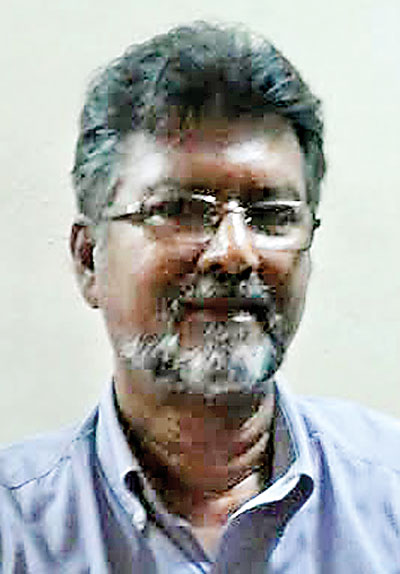

Illegal use of Colombo tube wells endangering people’s health
Colombo’s water table is highly compromised, and using this water via tube wells can lead to the public contracting any number of diseases, and even death, say CMC officials
By Kasun Warakapitiya
Despite warnings from the Colombo Municipal Council (CMC) to refrain from using tube well water obtained in Colombo city, small time hoteliers are said to be secretly making use of ground water.
CMC Chief Medical Officer Dr. Ruwan Wijeyamuni told the Sunday Times that they banned the sinking and use of tube wells within City limits due to the excessive pollution of water. He said that last year the CMC had raided several eateries which used ground water from illicit tube wells.
The CMC is able to detect if ground water is being used by examining the water bills of hotels and restaurants in their annual registration of eateries. “If any eatery is found using ground water, they will not be allowed to operate. We will cancel their licence,” Dr. Wijeyamuni said.
He said that food prepared using tube well water becomes contaminated, while plates washed with such water will, likewise, contaminate the food.
“The Colombo water table is very high up; therefore water can be reached after drilling to a depth of five to ten feet. Colombo is marshy land where water is collected very high in the soil, with little filtration, so it has various contaminants,” he said.
Dr. Wijeyamuni pointed out that in the dry zone, ground water reserves were purer, since they are found at a depth of over forty feet. But in Colombo the water body is polluted by septic leakage and drainage water.
He explained that over a hundred pathogens including types of bacteria, such as E. Coli, were discovered when samples of ground water were tested a few years back. Even discarded battery components including heavy metals such as Lead, Cadmium and Nickel are found in Colombo’s tube well water, as well as unknown viruses, fungi and worms.
“Ingesting polluted water can result in Typhoid fever, Hepatitis, fungal and bacterial infections, poisoning, worm infestations and even death,” Dr. Wijeyamuni cautioned. He added that the Colombo ground water should not be used even for bathing or washing clothes as this can lead to skin rashes, eczema, allergic reactions and eye infections.
CMC Analyst R.M.G.B Rajanayake said that the Colombo water table was contaminated due to industrial and commercial activity. He said that when the water was tested at the CMC laboratory they found Ammonia, Nitrates and Nitric components. The water was heavily mixed with sewage and garbage which had seeped underground.
Mr. Rajanayake pointed out that the water could even contain toxic waste and heavy metals, and therefore people should refrain from using Colombo groundwater.
Source – 21/05/2017, The Sunday Times, See more at – http://www.sundaytimes.lk/170521/news/illegal-use-of-colombo-tube-wells-endangering-peoples-health-240874.html

Simple solutions for a complex problem
Testing pond water on Delft Island (Kumudini Ekaratne © IUCN)
Sharing this meagre amount of freshwater among the world’s populace is not an easy task, and a distressing statistic reveals that one in every nine people in the world does not have access to safe and clean drinking water. Climate change will exacerbate these conditions and it is projected that by 2025, about 1.8 billion people will live in water-scarce areas, and two-thirds of the world’s population will live in water-stressed regions.
Although Sri Lanka is not considered a water-scarce country, there are sharp temporal and spatial variations of water availability within the island. Much of the island lies in the dry zone where, for several months of the year, water is scarce and this is the area from which 90% of water withdrawals are made. In some districts — in the arid zone of Sri Lanka, in Puttalam and Jaffna — for example, the total available water resources are considerably below the recommended levels for a decent quality of life. This situation will only worsen with the combined effect of the predicted impacts of climate change (a reduction in rainfall), a projected increase in Sri Lanka’s population and changing lifestyles needing more water.
Adding to the stark picture are human activities that pollute and poison surface water, and over- abstract ground water. Contamination of ground and surface water through agricultural and industrial pollutants is reported to be the cause of several water-related diseases being reported from the dry zone.
Managing our water resources — controlling the use of water resources to minimise damage to the environment and to maximise efficient beneficial use — has now become critically important in Sri Lanka. As stated by UN Water ‘Water resource management is complex, as it involves managing an uncertain supply to meet increasing and equally uncertain demands, balancing social needs against ecological and economical needs and management across sectors, policies and physical infrastructure.’
Two grant recipients of the Small Grants Facility of Mangroves for the Future (MFF) initiative, implemented by IUCN, took a different approach, looking at two simple elements of water management in Delft Island, where fresh water availability is a major problem. There are no rivers on the island; the ground water aquifer in the island is highly saline; and the island receives a mere 750 mm of sharply seasonal rainfall every year. The major source of freshwater for daily human needs is surface water collected in ponds (depressions on the surface which are filled with runoff water), waterholes and shallowly dug wells. Limited supplies for drinking water are provided intermittently by the Sri Lanka Navy and the National Water Supply and Drainage Board and a reverse osmosis plant (where seawater water is desalinised to make fresh water).
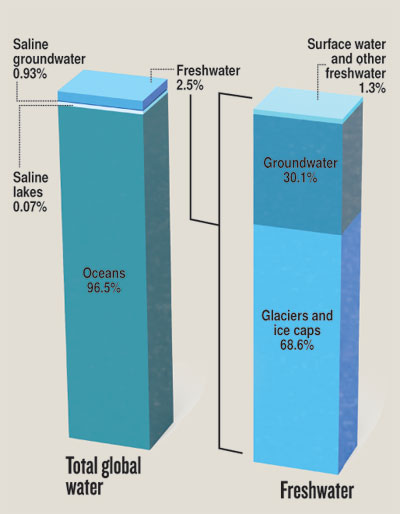
The first grantee — the Jaffna Science Association, Faculty of Science, University of Jaffna Association (JSA), a registered charitable organisation engaged in promoting science among the public — installed a 30,000-litre rainwater harvesting system at Delft MahaVidyalayam, collecting rainwater during the rainy months, instead of letting it runoff, and storing it for later use. To increase awareness about water conservation, they conducted a workshop for 99 middle and upper school students and taught them how to develop and maintain a school garden, using this stored water but managing it carefully, using pot and drip irrigation system for a sand-bag based vegetable garden. (The soil in the school garden is sandy and not suited for cultivation.) Pot irrigation uses clay pots filled with water buried next to growing plants. The porous wall of the clay provides controlled irrigation to the plants and reduces evaporation. Drip irrigation delivers water directly to the roots of plants through a network of rubber hoses. Pot irrigation conserves 50-70% water and drip irrigation, 20-50% water.A hundred clay pots were given with Jambu plants to the students as this species grows well in the dry zone. Students and teachers are now fully engaged in this school gardening activity and are harvesting 15 kg of tomato, 3.5 kg of chilli and 15 kg of aubergine per a week during the harvesting period.These vegetables are now being used to prepare school lunches.
The JSA then expanded their ambit by recruiting 26 beneficiaries from the Sarapittiya village, training them in drip irrigation, and supplying them with vegetable plants.These 26 farmers are now each trained to cultivate 15’ x15’ plots of lands using a water-saving method. They were also trained in vermicomposting, which uses earthworms to hasten natural composting of garden waste for use as fertiliser. All beneficiaries received a vermicomposting unit. Farmers say they have been able to double their income as a result of these changes.
The simple thrusts of these interventions were to teach children and communities to conserve water, initially by collecting what would be wasted, and then by using that collected water sparingly.
The second grantee — the Department of Fisheries at the University of Jaffna identified all ponds/waterholes in Delft Island based and restored a small pond as a model in order to reduce water scarcity among the community in the Delft Island. Firstly, they identified and mapped 37 ponds and 23 water holes, noting that salt water intrusion and sandy soils, combined with high temperature, results in high natural salinity levels. Next, they tested water samples — both in the dry and wet seasons — from 37 ponds and 23 waterholes, for water quality, such as temperature, electrical conductivity (which measures nutrients, salts or impurities in water), total dissolved solids (again, measuring impurities) and dissolved oxygen (a dissolved oxygen level that is too high or too low can harm aquatic life and affect water quality). Water quality — such as salinity, electrical conductivity and dissolved oxygen— in these water bodies increased markedly in the dry season, indicating that they were unsuitable for drinking but could be used for agriculture and for livestock.
As the next step, one pond Thoddichchakulam was restored. Traditionally, associated with the ponds are wells and kerny dug by communities. The latter is dug deeper than ground level, for storing and reserving water for livestock and other animals, while the well is deeper still. During the wet season water collects in the kerny and this water remains during the dry season for livestock, and there is a sloping platform through which the animals access the water.
Researchers from the Department of Fisheries widened the pond, built an earthen ridge to secure it, strengthened and stabilised this ridge by planting Kumbuk/Marudu (Terminalia arjuna) trees on it, cleaned the well and kerny, and raised the wall of the well, preventing pollution during the wet season. Through this physical and ecological restoration, the water storing capacity of the pond doubled. Water in this restored well was tested for heavy metals and found to be free of them.
Again, this grantee’s interventions were simple: to identify the ponds and waterholes, assess the quality of water during dry season and wet season, and to restore a pond as a model to retain more water to be used in the dry season.
Water resource management in Sri Lanka has been dogged by a lack of a unifying water policy, a surfeit of water-related laws and multiplicity of organisations, with a singularly sectoral focus with conflicting legislation, overlapping mandates and ill-defined responsibilities. A paradigm shift in thinking has been called for but the process of developing a unified water management policy remained mired in complexity.
The MFF grantees interventions exemplify Jed Rubenfeld’s (a Yale professor of law) and Robert Collier’s (an American author) combined comments: ‘Don’t try to figure it out all at once’ . . . ‘break the problem into parts, and handle one part at a time.”
This experience in the Island of Delft may also provide insights into water management in many other parts of the country.
Source – 21/05/2017, The sunday times, See more at – http://www.sundaytimes.lk/170521/plus/simple-solutions-for-a-complex-problem-240473.html

Lunawa lagoon –an environmental nightmare
The pristine Lunawa lagoon in Moratuwa -the only lagoon in the Colombo district- is in danger of turning into polluted eyesore with private sector factories as well as railway and bus depots discharging effluents into it.
The biggest culprits are two government institutions –the railway workshop and the SLTB depot at Ratmalana which channel oil waste into the lagoon.
During the colonial era the British installed a cleaning plant to cleanse the waste before releasing it into the lagoon. While the facility is still usable it is not being used.
Environmentalists are concerned that chemical inputs mixed with salt water in the lagoon could destroy living organisms in these waters.
The issue was raised at the Development Committee meeting of Moratuwa this week. Through warnings and threat of litigation, local government authorities feel they have been able to minimise the disposal of waste water and oil into the lagoon, but it is the two state institutions which pose the biggest environmental problem to the lagoon.
Source – 21/05/2017, The Sunday Times, See more at – http://www.sundaytimes.lk/170521/news/lunawa-lagoon-an-environmental-nightmare-240832.html

Two elephants rescued from well in Hambantota
A female elephant and her calf who had fallen into an agricultural well in Bathalayagama, Hambantota have been rescued by officers from the Hambantota Wildlife Range Office.
After being informed of the two trapped elephants he officers used a backhoe to dig a path for the elephants to get out of the well. The operation took over an hour.
Wildlife officers believe that the two elephants had remained trapped inside the well for about two days.
They also said that the trunk of the baby elephant exhibited signs of injury. It is suspected that the elephant had been injured after getting caught in barbed wire in a trap set by hunters.
Story and Pix by Rahul Samantha Hettiarachchi
Source – 18/05/2017,Times Online, see more at – http://www.sundaytimes.lk/article/1022142/two-elephants-rescued-from-well-in-hambantota

Biodiversity and Sustainable Tourism
Biodiversity Sri Lanka will commemorate the International Day of Biological Diversity which falls on 22nd May each year, with an evening session on the UN designated theme for 2017: ‘BIODIVERSITY AND SUSTAINABLE TOURISM’. This session will feature four relevant and illustrative case studies from Sri Lanka and the Asia region presented by Ms Maeve Nightingale of IUCN, Asia, environment and wildlife expert, Dr Sumith Pilapitiya, Mr Madhura de Silva, President, Wildlife Conservation Society, Galle and Mr Ross Sanders, General Manager, Anantara Peace Haven, Tangalle, covering areas such as the significance of the coast around us and carrying capacity and biodiversity issues in our national protected areas. The event will be held on the 22nd of May from 5.00 p.m. to 7.00 p.m. at the Auditorium of the Hatton National Bank, 22nd Floor, HNB Towers, No. 479 T.B. Jayah Mawatha, Colombo 10, and is open to the general public.
Biodiversity, at the level of species and ecosystems, provides an important foundation for many aspects of tourism. Recognition of the great importance to tourism economies of attractive landscapes and a rich biodiversity underpins the political and economic case for biodiversity conservation. A well-managed tourist sector can contribute significantly to reducing threats to, and maintain or increase, key wildlife populations and biodiversity values through tourism revenue. Although Sri Lanka is a small island, its biodiversity is significantly important both in a regional and global scale. The island has been declared as one of the 25 “biodiversity hotspots” of the world. Sri Lanka’s tourism is the country’s third largest foreign exchange earner and contributes a substantial percentage towards the GDP. In post-war Sri Lanka, tourist arrivals have seen a remarkable increase and there is a significant increase in investments in tourism as well as, infrastructure development through opening up of new tourist attractions.
The theme for this year is primarily about ensuring greater control and management to reduce damage to biodiversity from tourism and pursuing the positive contribution of tourism to biodiversity awareness, protected areas, habitat restoration, community engagement, and resource mobilization. This theme therefore provides an opportunity to raise awareness and action towards the important contribution of sustainable tourism both to economic growth and to the conservation and sustainable use of biodiversity.
Biodiversity Sri Lanka (BSL) is an entirely private sector owned and driven not- for-profit platform established to promote strong engagement of the corporate sector in Biodiversity and environmental conservation issues in Sri Lanka. BSL actively promotes strong leadership of the private sector in these areas through active learning, providing technical support, sharing information, knowledge and experience, promoting best practices and dialogue with state and civil society partners. Currently, over 65 leading corporates are members of the Platform.
Source – 18/05/2017,Adaderana Biz, see more at – http://bizenglish.adaderana.lk/biodiversity-and-sustainable-tourism/

